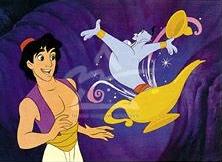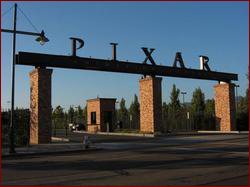There are contract negotiations that age you but make you smarter. Then there are negotiations that age you and make you stupider...
I'm still trying to decide into which category I would place the 2000 edition. But know one thing: the nine-month-long talks definitely wore me down. (Note the photograph above. I had brown hair then. And more of it.)
In late '99, TAG was in the last eight months of its then-current three-year contract. Animation writers were aware of this, and got active. They came to membership meetings in sizable numbers. And TAG's then-forming negotiation committee (the group of guild volunteers who draw up proposals and negotiate the contract) filled up with writers.
Animation writers had an agenda: they were very serious about gaining WGA-style residuals -- the kind that would go directly into their pockets instead of the Motion Picture Industry Pension and Health Plan, which was the recipient of IA-style residuals. And they had a valid gripe: live-action scripters got extra payments into their pockets, why not them? And freelance writers never saw pension benefits and health coverage unless they wrote enough scripts to get a qualified pension year. Many never got enough script assignments to see much of anything beyond their writing fee.
I didn't blame the writers for wanting more money. Beyond the issue of fairness, it's the way people keep score in the movie biz (and everywhere else, for that matter.) And it soon became clear that TAG was going to have major residual proposals in the 2000 negotiations.
But I knew from hard experience that Writers Guild type resids were going to be tough to get. (Like, close to impossible.) Nevertheless, I ran around to various studio labor relation execs that I knew and began probing about the possibility of getting some kind of residual structure started. Most executives were iffy. A couple, however, thought maybe some kind of deal could be reached.
Meanwhile, the newly-minted 2000 negotiation committee drafted its proposals on wages, on credit arbitration, on a new residual structure. This took a sizable chunk of time, but within a few months we were ready to rumble.
In late '99 or early 2000 (I forget which, and I'm too lazy to go look up the exact date) we met with the animation producers at the Alliance of Motion Picture and Television Producers in Encino. We presented all our proposals, then handed them in writing to our company counterparts. The studio reps received them in tight-lipped silence, said they needed a little time to digest them, and said they'd get back to us.
By and by they did. They told us residuals were out of the question. "You already get residuals under the IATSE contracts," the producer reps said. "They go into the pension and health plans. We're not giving you more." Our side pointed out that writers saw little of this, and profits from scripts they had written flowed into the trust funds but not to them. And if they didn't qualify for pension and health, well, the IA residuals did them no good, because they never got any.
The producers didn't care. They said no way, no how.
So the negotiating committee made new proposals. Different formulas, less sweeping changes to the existing contract. The producers responded "ixnay."
This went on for months. We'd propose, and the companies would say no. After which TAG's contract committee would have a lengthy caucus where we'd argue among ourselves, and committee members would say how unreasonable and unfair the companies were being.
And the next month we would meet for another round of negotiations. With the same result.
And somewhere along in here board artists decided that writers were trying to get control of screen credits, and that they might get screwed. And the artists got angry, which led to a large, tense meeting with a hundred artists and several writers in attendance. Various tempers flared and nobody was particularly happy, but the writers said they weren't trying for any credit grab. And the negotiations went on.
Through all of this I tried to be mindful of the people working in other job classifications who were not sitting at the bargaining table. It was pretty clear that we weren't getting anywhere, and weren't likely to get anywhere if we didn't pull our "non-starters" off the table. But the committee wasn't keen to throw proposals it held dear into the waste basket. A majority of the committee didn't think it was fair that animation writers were the only unionized scripters in Hollywood who didn't get the kind of deal their live-action siblings got.
I replied it wasn't a question of fairness, but one of leverage: You either have the muscle to get what you want, or you don't.
We were in the "don't" category.
The contract deadline was almost up, and both sides of the table were getting antsy. (At one point, in caucus, a writer grunted: "This is like high school student council. We get to debate, we get to vote. But the faculty and school administration has all the damn power." I said "Yeah, pretty much.")
I let the producers know we were dead in the water. Nobody was willing to pull anything else off the table. Soon thereafter, our mother international called to ask for an update. Soon after that, IA President Tom Short sat with us for the next round of talks. Before we met with the producers, we caucused.
Ten minutes into our pre-meeting, a shouting match erupted. It came down to: President Short insisted on jettisoning our last, watered-down residual proposal, and the writers didn't want to budge. As the decibel level rose, I remembered documents I had to photocopy and scampered from the room.
When the shouting ended, the last negotiation session with the producers went quickly. We talked with them in the big room, then in side bar. We ended up with major movement on health coverage, achieving six months of health insurance for freelance writers who wrote two half-hour scripts and outlines. This was a big improvement over the status quo.
But it wasn't a new deal for residuals.
The writers weren't happy with the package brokered by the IA and voted "NO" on its ratification. Since they were a majority of the committee, that was the way the committee came down. As chairman of the group, I didn't vote. But knowing we weren't going to get a better deal and that the IATSE wouldn't authorize a strike (besides which, we couldn't have gotten a majority of members to approve one if we'd tried), I campaigned for ratification.
Arguments pro and con were mailed out; a week later, ballots went to the membership. And when the dust cleared and all the votes were counted, the 2000 TAG Collective Bargaining Agreement passed by an 84%-16% margin.
Like I say. Some negotiations age you more than others.
(Here's an overview of another writers' negotiation. It's worth taking a few more minutes to read...)
* Seated: Stan Berkowitz, Robert Goodman, Hillary Baiter, Lee Crowe, unidentified. Standing: Unidentified, Earl Kress, Brooks Wachtel, John Behnke, Brain Swindlin, Warren Greenwood, Bronnie Barry, Steve Hulett, Stephan Zupkas.









































